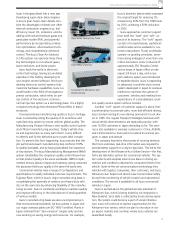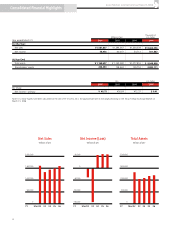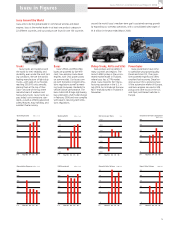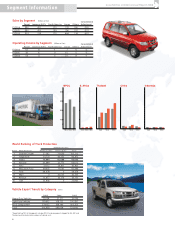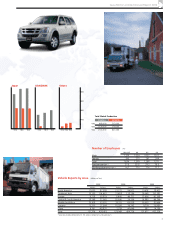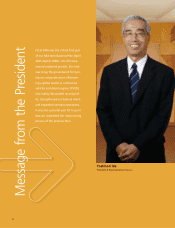Isuzu 2006 Annual Report Download - page 15
Download and view the complete annual report
Please find page 15 of the 2006 Isuzu annual report below. You can navigate through the pages in the report by either clicking on the pages listed below, or by using the keyword search tool below to find specific information within the annual report.
13
New development method for light-duty and medium-
duty trucks reduces costs of global strategic products
In 2006, Isuzu adopted a new, cost-saving approach to
new vehicle development. We previously developed light-du-
ty and medium-duty truck models separately, but from now
on we are integrating design and development processes for
light-duty and medium-duty trucks, advancing shared use
of components, and reducing overall development costs by
approximately 20%. We have positioned these new trucks
as global strategic products, designed for global markets to
world standards. The first models developed under this new
system are scheduled to go on sale in Japan in late 2006.
Development of basic heavy-duty truck model with
add-ons to fulfill regional specifications
We have also reviewed the way we develop heavy-duty
trucks. Our traditional approach was to develop a model for
the Japanese market, and then develop separate models for
each region based on the domestic model. Moving forward,
we intend to develop and design basic safety and other fea-
tures for the most basic model supplied to markets such as
Southeast Asia and China, and provide add-ons as required
to meet the specifications for other markets like the US,
Europe, and Japan. We expect to begin selling heavy-duty
trucks developed under this new system in a few years’ time.
Leading the way in in-house development
Isuzu has continued to invest in R&D of its core powertrain
technologies despite the financial pressures of restructuring,
because of the highly sophisticated technological standards
required of today’s diesel engines for trucks and buses in the
context of increasingly stringent environmental regulations.
The new long-term exhaust emissions regulations that went
into force in October 2005 are said to be the toughest in
the world, requiring an 85% reduction in particulate matter
(PM) and 40% NOx reduction compared with the previous
short-term regulations introduced in 2003. New models and
existing models in continuing production cannot be sold un-
less they satisfy these requirements by September 1, 2007.
Improving powertrain performance by the use of sophisti-
cated control technology is essential in order to comply with
these standards.
Because of the level of technical sophistication required,
most manufacturers opted to outsource development to
leading automotive suppliers. But Isuzu decided to develop
its own with electronic component company, Transtron Inc.,
founded as a joint venture with Fujitsu in 1990. Manage-
ment consensus about the need to make a point of differ-
ence in development overrode skepticism about whether
the company was capable of the task.
The first model to incorporate Isuzu’s own control tech-
nology was the light-duty truck ELF KR, which went on sale
in 2002. It drove our steep earnings recovery as a best-selling
model that complied with the 2003 emissions regulations
before they went into force.
Isuzu also developed its own control software capable of
precision control of the whole engine, including fuel injec-
tion technology controlled by units of 0.001 second. The
technology came into its own in the 4HK1 engine for the
FORWARD medium-duty truck, which complied with the
new long-term emissions regulations. The new control tech-
nology enabled Isuzu to improve engine performance with-
out relying on complex exhaust gas after-treatment technol-
ogies like many of our competitors.
Even tougher emissions regulations are on their way. From
2009, emissions regulations for diesel engines will be similar
to those for gasoline engines, requiring a 40%–65% reduc-
tion in NOx compared with the new long-term regulations
and virtually zero PM. Isuzu is tackling this challenge with a
three-pronged approach to clean diesel engine technology.
Super-clean diesel technology with I-CAS
The three key technologies for super-clean diesel engines
are integrated in the Isuzu Clean Air Solutions (I-CAS) sys-
tem. I-CAS aims to maximize the advantages of diesel en-
gines—durability, excellent fuel efficiency, and lower CO2
emissions—while overcoming their disadvantages by inte-
grating optimal combustion technology, after-treatment
technology, and comprehensive electronic control. By opti-
mizing these three key technologies, I-CAS reduces exhaust
gases, lowers CO2 emissions, and boosts performance.
Isuzu’s optimal combustion technology consists of an
intercooler for turbo and fuel injection technologies that
achieves ultra-high-pressure fuel injection to control and
optimize the injection pressure, timing, and amount. After-
treatment technology further cleans exhaust expelled by the
engine using a catalytic agent. Isuzu developed an oxidizing
catalytic converter and Diesel Particulate Defuser (DPD) to
cut PM emissions, and is working on research and develop-
ment of the Urea-Selective Catalytic Reduction catalyst and
NOx catalyzing technologies to reduce NOx emissions. Our
electronic control software precisely controls these two tech-
nologies with the use of an engine sensor and feedback con-
trol technologies.
Having developed our own electronic control technology,
Isuzu today leads the industry in electronic control software
that maximizes the capabilities of diesel engines. One of
the technologies critical to the development of super-clean
diesel engines is homogenous combustion, which relies on
precise control of the electronic common-rail fuel injection
system. Isuzu is one of the Japanese diesel engine manufac-
turers excelling in this technology, which eliminates PM and
NOx in diesel emissions.
Development of DPD
The Diesel Particulate Defuser (DPD) is an after-treatment
system that uses a ceramic filter to collect and burn the par-
ticulate matter in exhaust emissions. The DPD burns PM ef-
ficiently and cleans exhaust emissions by employing common
rail fuel injection with multistage injection control, and an
exhaust throttle in addition to Isuzu’s unique exhaust tem-
perature control. This fuel injection control system achieves
optimal combustion treatment by optimal fuel injection pres-
sure, timing, quantity, and frequency with automatic control.
Isuzu Motors Limited Annual Report 2006


